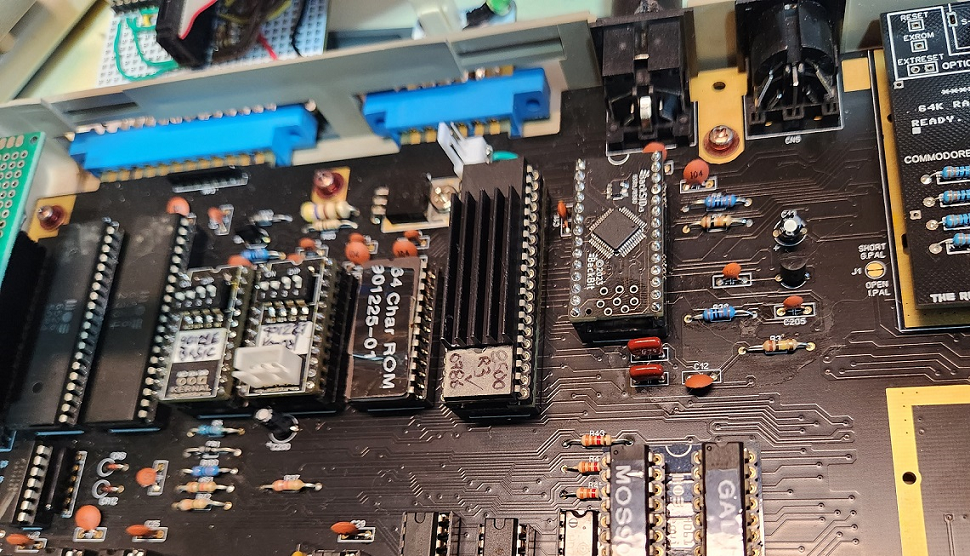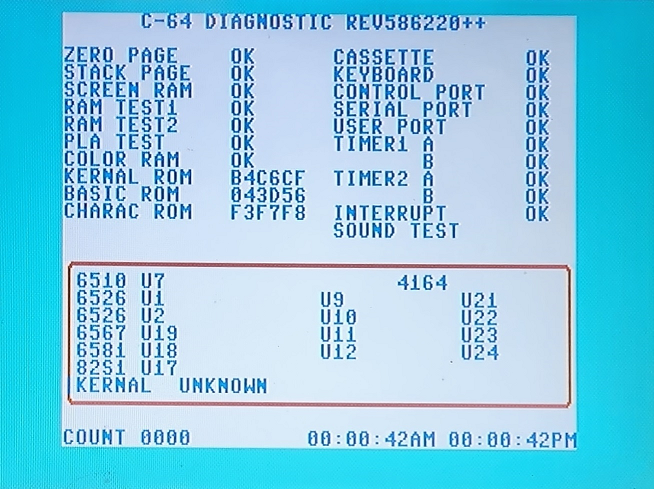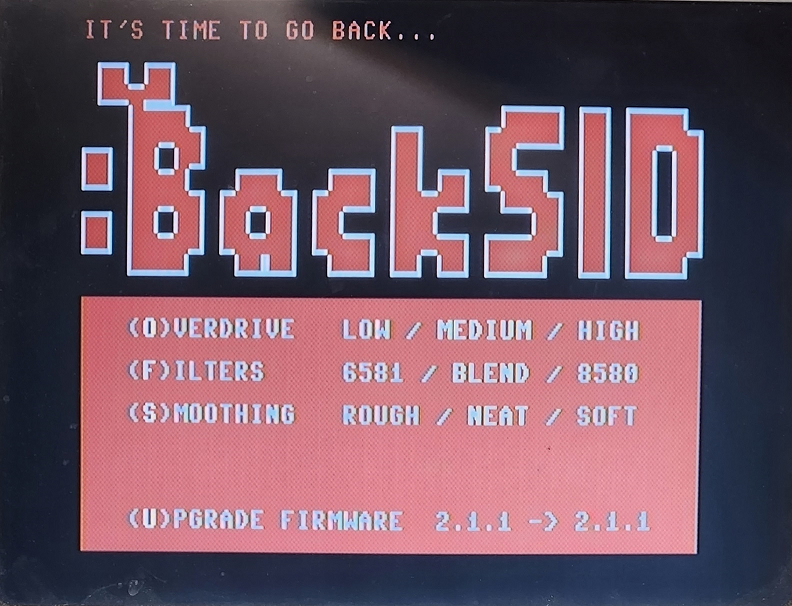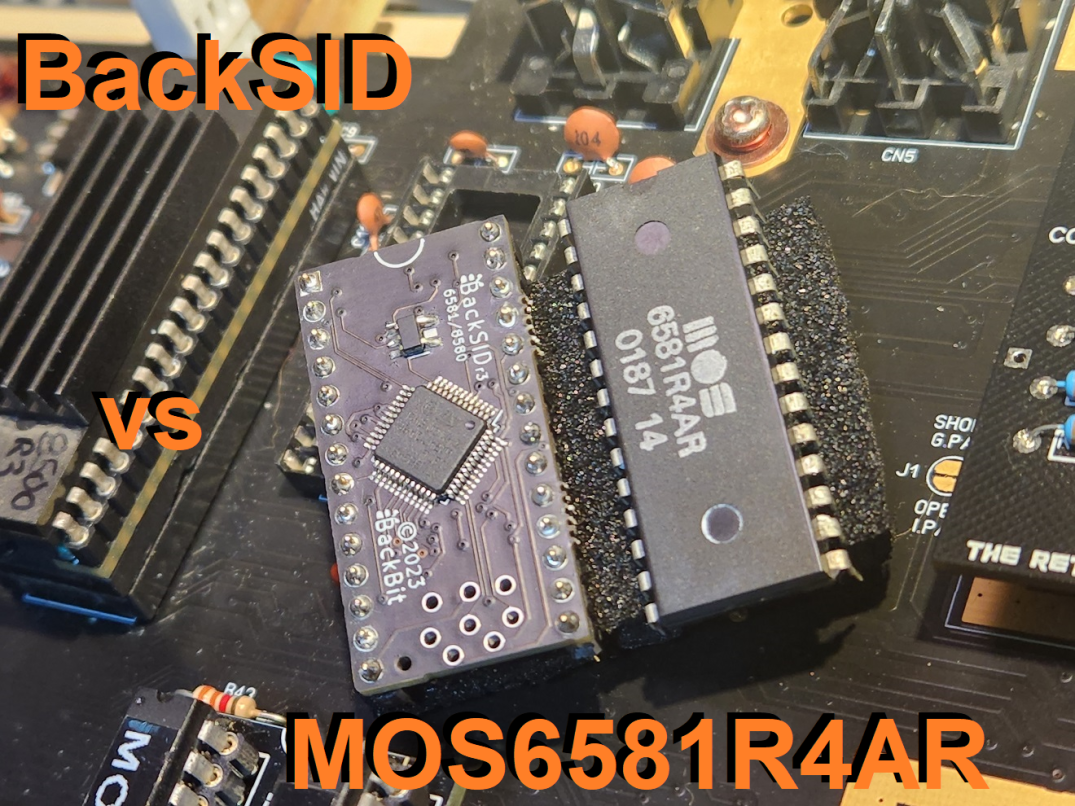I’m a geek, you’re a geek, we’re all geeks.
And when we built a Commodore 64 we needed something to replace the 6581 Sound Interface Device
MOS 6581 “SID” chip is the audible output of a Commodore 64 computer. It was revolutionary when it was released in the 1980s, and made it’s way in synthesizers and gave its sound to the Commodore 64.
This chip has an analog nature, filtering, and could produce 3 simultaneous voices – much better than anything IBM’s “personnal computer” could produce at the time.
When we built the 250466 reproduction board, the SID was borrowed from another C64. That meant one of the two Commodore had no audio output. It meant silent gaming and no music.
Shopping for a SID chip online has it’s share of frustration and getting a genuine, working one isn’t guaranteed. The scarcity of the chip has the side effect of increased pricing. An 6581R4AR like the one borrowed for the build can fetch north of 100$ on auction sites.
The repro chips are a bargain by comparison. And will be much more future proof than 40 years old microchips.
A question remain – Do they sound the same?
Click here for more articles on the Commodore 64
This article follows a previous one describing possible SID chip replacementsShipping online for repro SID chips, we ended up ordering one BackSID from Evie at BackBIT no affiliations with wereallgeeks.
I’m a geek, you’re a geek, Evie’s a geek too. A geek that enjoys music, electronics, and retro computers. BackSID is a replacement SID chip for geeks, by geeks, with a nice online forum for support.
Ordering online trough the shop means a replacement SID chip for much less as a vintage one in online auctions, faster shipping time than ordering from any asian online stores, and much higher chances of getting something that will work in the long run.
Package came in within about a week.

Then was the burden of installing the chip. Original SID chips came in two flavors – 6581 and 8580. One being NMOS and the other HMOS meant their supplied voltage differed. The BackSID was designed with this in mind and will detect the motherboard’s supplied voltages and adjust audio output accordingly. Unless we configure it otherwise. More on that later.
This means the BackSID is a drop-in replacement no matter what motherboard is being used, and no care need to be made about the version of boards or SID – voltage will be OK.
Therefore installing the chip was a simple socket swap. In fact, we swapped the real SID to the BackSID several time for comparisons. See the video below.

Up came the initial test. The BackSID is fully paddle compliant, including diagnostic test with full harness.
Therefore, we felt a good way to ensure the one we received was in working order was to test it out using our own harness and diagnostic cart.

The chip has the correct paddle response to pass the harness diagnostic test. This means a C64 with a BackSID can still be diagnosed with a variety of issues including bad CIA chips.
This isn’t the case of every SID replacement, as some of them don’t cover for the Paddle. No paddle output means the CIA1 is always reported as wrong in the diagnostic. It also means it may be complex to diagnose an agonising CIA.
But with the BackSID this is not a problem, diagnostics can be performed just like with a genuine C64.

That being said, a Commodore is much more than a diagnostic result, let’s try it out.
Turning on
When turning on a Commodore 64 – any normal Commodore 64, a barely noticeable whitenoise is generated. We can faintly “hear” the silence. This is not exactly noticeable unless one pays attention to it and won’t record super well.
In that regard, the BackSID is more quiet. The digital nature of the chip makes for less noise when “silent.”
On the other hand, we hear the chip waking up at power-on and starting to generate [no audio] – it is heard in a very faint “thick” as power is applied. It is the transition from “no audio” to “generating silence”. Nothing powerful or noticeable, nothing to harrass any amplifier, it is just there.
Silence and power-up sounds different than the original SID chip, but doesn’t grab attention. Most of the experience is of a very good sound quality.
We could play a few games for audio and paddle tests, and play SID music.
Discrepancies
The BackSID isn’t a set of specs reverse engineered and made in a chip like the PLA reproductions but rather a recreation of the audio interface device, programmed from scratch – this also means Evie had to manually make the features of the audio envelope to make it sound like the original chip, essentially making the games and music sound right. Everything is programmed in the chip to make it as authentic as possible.
The programmers of the 80s would used tricks and hacks to produce unique sounds from the SID chip, and this means modern recreation of this same sound via software over brand new hardware isn’t exactly straight forward. Particularly when it comes to Ring Modulation – the chip’s way to make unique sounding waveforms. Or syncing the voices the exact same way as the original one. Any weird artifact that the programmers could have used to make specific sounds needs to be programmed into the replacement chip. Making the modern counterpart sound exactly like the original is where the challenge is.
There are user requests in the BackBIT forum’s BackSID section where users and beta testers post about a specific audio feature that isn’t reproduced perfectly, and this generally ends up with a new firmware being made available to resolve the issue a few days later. As of writing this article, the latest firmware is version 2.2.0 and dates from late August 2023.
Just during our series of tests leading to this article, the BackSID changed firmware twice…
All in all, this makes for a very geek-friendly correction process, and a nice collaborative approach into making the BackSID what people want it to become: a great recreation of the SID chip.
But that leads to the next step: upgrading firmware!
Settings and firmware
The board’s firmware is manually installed prior to shipping a BackSID to end users – us geeks. In theory this ensures the latest firmware is present when receiving the device.
But the firmware can be upgraded, and this is done from within the Commodore 64. As mentionned in the instructions card that comes with the BackSID, one can download the setup program from BackBIT’s BackSID firmware download section.
It is a [zipped] .PRG that can be copied to many modern interfaces for the Commodore 64 – we like pi1541. The setup program helps configure some tweaks of the audio output, as well as a firmware update – essentially one firmware is present in the .PRG.

The BackSID can be instructed to sound like the original MOS 6581 SID or the latter incarnation MOS 8580. Or a mix of both. This is mainly a matter of how the filters are implemented.
The audio output can also be adjusted to some degree with more or less overdrive (distortion anyone!?) and more or less smoothing – this is an artifact of having a Digital SID instead of an analog one.
Settings aren’t super elaborate, we whish more options would be present for a super personalized audio experience. Maybe customizeable filters?
But this software offers end-user control over how the chip will sound, and Geeks enjoy such features.
Comparisons
Here are some audio comparisons of the BackSID.
The idea is to compare BackSID with an actual SID chip – an 6581R4AR [considered by many to be the better sounding SID chip]
Also, the BackSID in various modes and settings to compare it’s possible outputs.
The recordings were made with BackSID firmware 2.1.2 a few days before the BackSID 2.2.0 was released
It is surprising how nuances can be subtle yet rather noticeable when put side to side. The various modes of the BackSID did sound different, but the differences really pops when put side-to-side in the comparative video posted above.
Tweaks are still somewhat limited, but overall they do sound great… after a few days of usage, we completely forget the chip isn’t a genuine MOS chip. It offers much more customization than the original and the effects, as seen above, can be interesting while sounding natural for the C64.
Keep in mind, even the original SID didn’t all sound all the same.
Would anyone miss their genuine SID chip if changing for a BackSid? we don’t think so. But for each geek their own.
Keep on geeking.
Related articles
Building the commodore 64 (wereallgeeks)
SID chips replacement (wereallgeeks)
Using C64 to play music (wereallgeeks)
A word on chip counterfeiting (wereallgeeks)
BackSID (backbit)
Building a C64 diagnostic harness (wereallgeeks)
Gal PLA replacement chip (wereallgeeks)
Ring Modulation (wikipedia)
PI1541 (C64 wiki)


Hi, thanks for the review. Would you please test the backsid with this 48Khz c64 audio demo.? I would like to find an emulated SID that can play it clearly like the real SID do.
That’s interesting!
This is exactly the type of test that needs to be done on the hardware to know if there are limitations.
Thanks a lot for bringing this to our attention!!
Will do and report back.
@John – Are there any other way of testing this out than installing it on an easyflash cart? Sadly that’s a piece of equipment we’re missing…
An Ultimate II+ cartridge is the best way to test/use various media on your c64 (easy flash, REU, replacement kernals, 1541, 1571, 1581, util and freezer carts, etc..)
Do you have a UII+ cartridge? https://ultimate64.com/U2PLRED
We have pi1541, magic desk carts up to 2M, normal carts, but no easy/kongfu flashes nor any REU or ultimate, sadly.
@John,
Discussed w/ Evie (CEO of BackBit) on the topic.
It does work, but the BackSID running at 32khz causes some distortion.